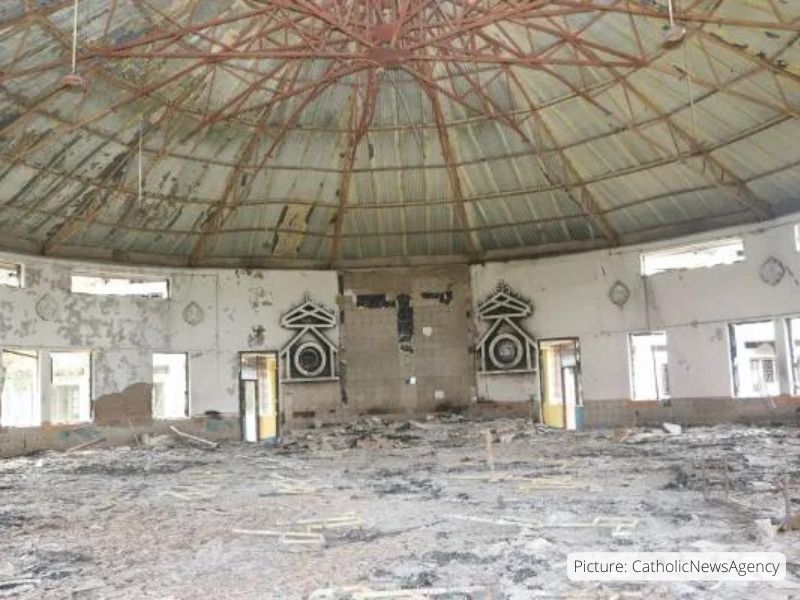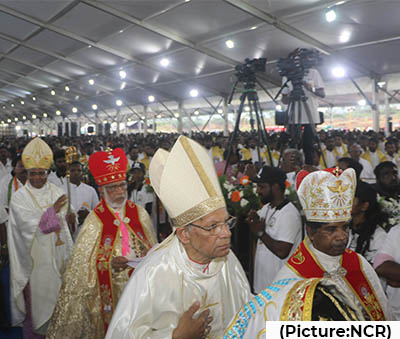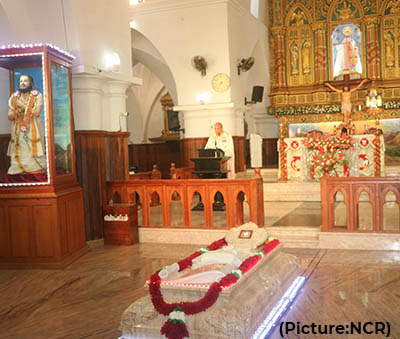Indian Prime Minister Narendra Modi, leader of the Hindu nationalist Bharatiya Janata Party (BJP), hosted over 100 Christian leaders from all denominations at his official residence on Christmas morning amid criticism for the continued persecution of Christians in India.
Several Catholic leaders, including Cardinal Oswald Gracias of Mumbai and Delhi Archbishop Anil Couto, who were seated on either side of Modi during the event, were in attendance.
The archbishop of the Syro-Malabar Church, Kuriakose Bharanikulangara, and Bishop Thomas mar Anthonios of the Syro-Malankara Church also joined bishops of different denominations and Christian leaders from different walks of life at the gathering.
Asked to comment on the meeting with the prime minister, considering the uptick in attacks on Christians in the country, Bharanikulangara told CNA: “Everybody knows what is happening … But when the prime minister invites [us], how can we decline?”
“It is for the prime minister to show that he is really concerned about the Christians,” said Bharanikulangara, a former Vatican diplomat.
“Christmas is an occasion to remember Jesus Christ’s life’s message and values,” Modi said, addressing the gathering of Christian leaders that included academicians and Christian businessmen from across the country. The prime minister went on to hail the service of the Christians, saying: “The nation proudly acknowledges the contribution of the Christian community.”
“Our government is ensuring that the benefits of development reach everyone and no one is left untouched,” Modi said, adding that many people of the Christian faith, especially poor segments, are benefitting from his government’s welfare programs.
Among several Christians who spoke during the two-hour program was Cardinal Gracias, who thanked Modi for his “efforts” on behalf of the country, the Christian community, and the world.
“Our country could be the leading country in the world,” Gracias said, according to an ANI report.
However, several Christians said they were skeptical about the motivation behind Modi’s Christmas meeting and his failure to address the steadily worsening persecution that has taken place in nearly a decade of Modi rule.
“This [Christmas celebration] is a political gimmick and image-making by Prime Minister Modi ahead of the next elections,” A C Michael, an outspoken Catholic activist, told CNA.
“We are concerned over the silence of Prime Minister Modi, who praises Christian service publicly but does nothing to stop the increasing violence and persecution of Christians,” pointed out Michael, coordinator of the United Christian Forum (UCF), which monitors atrocities and incidents of persecution against Christians.
UCF published a report Dec. 8 recording 687 incidents of violence against Christians in 334 days of 2023 (from the start of the year to the end of November). The report further said that while only 147 incidents of violence against Christians were reported in 2014 (when the BJP regime under Modi came to power), the incidents steadily spiraled to reach 687 by November’s end.
Armed with this data, Michael along with Catholic activist John Dayal and Supreme Court lawyer Sister Mary Scaria addressed a news conference with secular activists on Dec. 28 in New Delhi on the Modi government’s “Lunch Diplomacy and Christian Persecution.”
“The prime minister is not only free but duty-bound to embrace the nation’s religious minorities and invite their leaders to functions at his house on Christmas. … But the Christmas spirit must not let us forget the condition and tribulations of our brothers and sisters who suffer because of government impunity and the brazen political elements who have no respect for the constitution of India and its guarantees of freedoms to the citizens,” the Catholic leaders lamented in their press statement.
“The persecution of the community is rampant, hate towards it from the highest quarters of nationalist religious leadership as deep as it can be,” they decried.
“The government seems keen to starve it [Christianity] out of existence by withdrawing the FCRAs [license to receive foreign donations] of a vast number of churches and its NGOs [nongovernmental organizations], and using the investigating agencies against cardinals and bishops, pastors and laypeople. In UP [Uttar Pradesh], for instance, over 100 pastors and even ordinary men and women are in jail under charges of illegal conversions when celebrating birthdays or conducting Sunday prayers,” the statement said.
Dayal, former president of All India Catholic Union, dubbed Modi’s Christmas hosting of Christian leadership as “just an eyewash to impress the Christians.”
“The prime minister has made a mockery of the pains of the Christian community by remaining silent and [was] not bothered to even visit bleeding Manipur,” Dayal told CNA Dec. 29.
“If he was concerned about peace and safety of the hounded Christians, he could have taken stern preemptive action to curb and stop the Manipur violence,” Dayal added.
Beginning in May, Manipur state in northeast India, which borders Myanmar, has witnessed a protracted violent ethnic clash between the majority Meiteis, most of them Hindus, and the minority Kuki tribals (almost all of them Christians).

Among the nearly 200 killed and over 60,000 displaced in Manipur, the overwhelming majority are Kukis who have been chased out from Meitei strongholds, such as the Imphal Valley, in the simmering violence.
Media and independent investigators have blamed the BJP-led state government’s condoning of the violence by Meitei groups that have also destroyed or damaged more than 600 churches.

 Indicating the esteem with which St. Devasahayam is revered, in attendance were four ministers of the Tamil Nadu state cabinet, led by the speaker of the state legislature, and Hindu leaders.
Indicating the esteem with which St. Devasahayam is revered, in attendance were four ministers of the Tamil Nadu state cabinet, led by the speaker of the state legislature, and Hindu leaders. He recalled, “Finally seeing my pitiable condition of being carried around like a baby, my mother relented. It was after weeks of stay and prayer at the care center [at the martyrdom spot] I had a vision of a man in a beard coming and asking me for water. I told him, ‘I cannot walk.’ He said, ‘You can walk’ — and, amazingly, I walked, after months, to bring water for him. But he was gone. Only then I realized it was the saint.”
He recalled, “Finally seeing my pitiable condition of being carried around like a baby, my mother relented. It was after weeks of stay and prayer at the care center [at the martyrdom spot] I had a vision of a man in a beard coming and asking me for water. I told him, ‘I cannot walk.’ He said, ‘You can walk’ — and, amazingly, I walked, after months, to bring water for him. But he was gone. Only then I realized it was the saint.” A peep into his life will amaze anyone. Vepa Shyam Rao was born on Sept. 21, 1939, in an orthodox Brahmin family in the Srikakulam district of Andhra Pradesh. By the age of five, he had lost both parents and grew up under the care of his maternal grandfather.
A peep into his life will amaze anyone. Vepa Shyam Rao was born on Sept. 21, 1939, in an orthodox Brahmin family in the Srikakulam district of Andhra Pradesh. By the age of five, he had lost both parents and grew up under the care of his maternal grandfather.